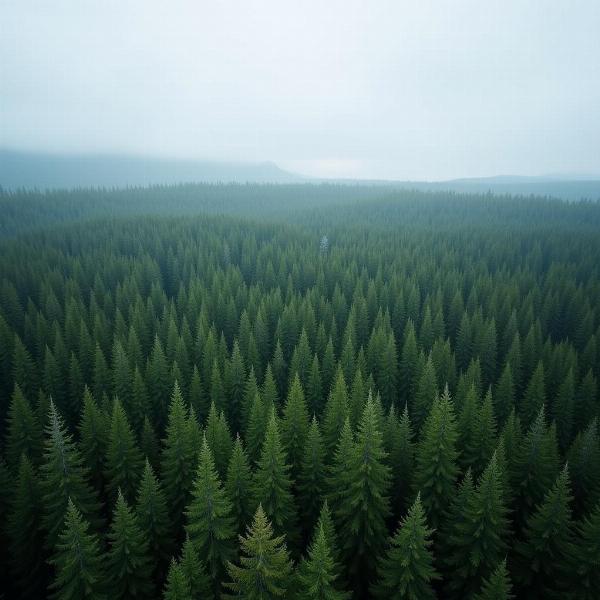Boreal forest meaning in Hindi is typically referred to as “उत्तरी शंकुधारी वन” (uttari shankudhari van), which translates to “northern coniferous forest.” Understanding the meaning and significance of these vast ecosystems is crucial, especially given their role in global climate regulation and biodiversity. This article will delve into the various aspects of boreal forests, including their characteristics, location, flora and fauna, and the threats they face.
 Vast expanse of boreal forest
Vast expanse of boreal forest
What Characterizes a Boreal Forest?
Boreal forests, also known as taiga, are characterized by long, cold winters and short, cool summers. They are dominated by coniferous trees such as pine, spruce, fir, and larch, which are adapted to survive the harsh climatic conditions. These forests are found in the high northern latitudes, just below the Arctic tundra. The soil is typically thin and acidic due to the slow decomposition of organic matter in the cold climate.
Where are Boreal Forests Located?
Boreal forests form a circumpolar band across North America, Europe, and Asia. They cover vast stretches of Canada, Russia, Scandinavia, and Alaska. This continuous belt of forest plays a significant role in the global carbon cycle, storing vast amounts of carbon in the trees and soil.
The Unique Flora and Fauna of the Boreal Forest
The boreal forest is home to a unique array of plant and animal life. Besides the dominant coniferous trees, you can find various shrubs, mosses, and lichens. Animals adapted to the cold environment, like moose, elk, wolves, bears, lynx, and various bird species, thrive in this ecosystem.
Threats to the Boreal Forest
Despite their remoteness, boreal forests are facing increasing threats from human activities. Logging, mining, and oil and gas exploration are fragmenting the forest landscape and disrupting the delicate balance of the ecosystem. Climate change, with its rising temperatures and altered precipitation patterns, poses another significant threat.
Conclusion
The boreal forest, or “उत्तरी शंकुधारी वन,” is a vital ecosystem with a significant role in global climate regulation and biodiversity. Understanding its meaning and the challenges it faces is crucial for its conservation. Protecting these forests is essential for maintaining the planet’s ecological balance.
FAQ
-
What is the primary vegetation of boreal forests?
Coniferous trees like pine, spruce, fir, and larch. -
Where are boreal forests predominantly found?
In the high northern latitudes of North America, Europe, and Asia. -
What is the Hindi word for boreal forest?
उत्तरी शंकुधारी वन (uttari shankudhari van). -
What are some of the threats to boreal forests?
Logging, mining, oil and gas exploration, and climate change. -
Why are boreal forests important?
They play a crucial role in global climate regulation and biodiversity. -
What kind of animals live in boreal forests?
Moose, elk, wolves, bears, lynx, and various bird species. -
What is the soil like in boreal forests?
Typically thin and acidic due to slow decomposition.
Meaning-Hindi.in offers comprehensive translation services specializing in various domains, including business and commerce, legal, technical, website localization, educational, and specialized fields. We are committed to delivering accurate and culturally sensitive translations to bridge the communication gap between Hindi and other languages. Our expertise in translating documents related to environmental science makes us an ideal partner for any organization working in the boreal forest regions. For high-quality Hindi translation services, contact us at [email protected] or call us at +91 11-4502-7584. Meaning-Hindi.in is your trusted language partner.